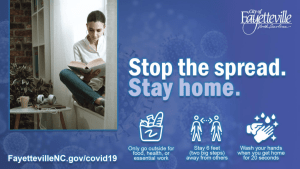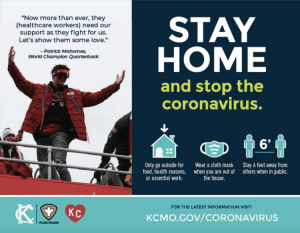Messaging that hits home: 5 tips from tests underway in U.S. cities
The COVID-19 crisis may be a watershed moment for applying behavioral science in cities, as civic leaders encourage residents to adopt new behaviors such as staying home, wearing face masks, and keeping six feet apart from each other.

Experiments to test what messages work best are underway or recently concluded in at least 10 U.S. cities — and results are emerging that other cities can use to inform their own communication approaches.
The cities are using online surveys to test a variety of messages using different communications channels. For example, Fayetteville, N.C., Kansas City, Mo., and Newark, N.J., tested different ways of encouraging residents to stay home using flyers than can be posted online or to social media; New Orleans ran a similar test using text messages. Kansas City also tested a flyer asking residents to wear cloth masks, and Portland, Ore., tested posters reminding grocery store shoppers to stay six feet apart.
The cities partnered with the Behavioral Insights Team (BIT), which supports cities to run low-cost evaluations through What Works Cities, a national initiative that helps cities use data and evidence to improve results for residents. BIT is holding a webinar Wednesday at 10 a.m. EDT to discuss findings from these and similar COVID-19 communications tests in the United Kingdom, or you can sign up to get the recording here.
Here are five takeaways from the work in U.S. cities so far:
1. Testing matters
Many outcomes were not what city leaders expected, and the “winning” message varied from place to place. That’s a reminder that it’s always smart to test and evaluate messaging, rather than fall back on assumptions, intuition, or hunches. “The messaging that works best varies from place to place,” said Kelsey Gohn, an advisor at BIT. “Each city should do some testing of their own communications, not just take it from somewhere else.
For cities that don’t have bandwidth right now to conduct a large online survey, there are light-touch ways cities can test their messaging, said Carolina Toth, who leads BIT North America’s work with cities. For example, social media platforms like Facebook make it easy to run A/B tests that show half your audience one message and half your audience another, so that you can gather data on what resonates locally. “That’s well within the capability of most city communication departments,” Toth said.
2. Try appealing to a “sense of duty”
In Newark, New Orleans, and Portland, messages that came out on top emphasized the sense of duty people should feel to protect others. For example, Newark’s best performer said: “Frontline workers are putting their lives at risk to keep you safe. It’s your duty to stay home and help protect them during this crisis.” The message scored best in terms of people being able to comprehend and accurately recall the public-health guidance as well as their intention to follow it.
3. Keep it simple
In Fayetteville and both trials in Kansas City, the best-performing messages were the simplest, most straightforward ones. Fayetteville’s best performer showed a picture of a woman reading a book at home and simply said: “Stop the spread. Stay home.” People are busy and stressed, so it pays to make key messages as simple as possible for them to consume, according to Michael Kaemingk, a senior advisor at BIT North America.
“Put the key information at top in large letters,” Kaemingk said, “and keep messages short. We had a handwashing poster where even shortening it from 52 to 34 words mattered in terms of comprehension and behavioral intent.” Basic imagery also helps: In fact, the Portland test found that an image-only graphic of shoppers keeping their distance performed just as well in terms of comprehension as the same image with text.
4. Localizing messages may not help
Several of the cities tested messages intended to put a local spin on the situation. Fayetteville tried a faith-based message aimed at tapping into a strong faith community as well as one meant to appeal to military families from nearby Ft. Bragg. New Orleans tried a text message that echoed messages locals may remember from after Hurricane Katrina. And Kansas City tested a message that used an image and quote from quarterback Patrick Mahomes of the Super Bowl champion Kansas City Chiefs. None of these were the top performers, losing out to either the “simple” or “duty”-oriented messages.
5. Men and young people may require more targeted messaging
In almost every test, men and younger people showed the lowest comprehension of the messages they saw and were least likely to say they would follow public health guidance. Men aged 18–24 proved most difficult to reach. “They’re reporting doing the highest level of doing the wrong things, or the lowest levels of doing the right things, depending on how we ask the question,” said Emily Cardon, head of research for BIT North America. “It might matter what photos you use. If you’re going to target young men in a social media campaign, you should likely include photos of other young men. It’s an area where cities should be iterating.”


